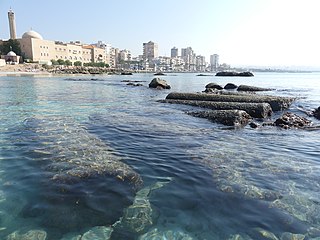
Tyre is a city in Lebanon, one of the oldest continuously inhabited cities in the world, though in medieval times for some centuries by just a small population. It was one of the earliest Phoenician metropolises and the legendary birthplace of Europa, her brothers Cadmus and Phoenix, as well as Carthage's founder Dido (Elissa). The city has many ancient sites, including the Tyre Hippodrome, and was added as a whole to the list of UNESCO World Heritage Sites in 1984. The historian Ernest Renan noted that "One can call Tyre a city of ruins, built out of ruins".

Beirut is the capital and largest city of Lebanon. As of 2014, Greater Beirut has a population of 2.5 million, which makes it the fourth-largest city in the Levant region and the seventeenth-largest in the Arab world. The city is situated on a peninsula at the midpoint of Lebanon's Mediterranean coast. Beirut has been inhabited for more than 5,000 years, making it one of the oldest cities in the world.
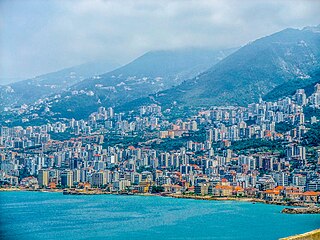
Jounieh is a coastal city in Keserwan District, about 16 km (10 mi) north of Beirut, Lebanon. Since 2017, it has been the capital of Keserwan-Jbeil Governorate. Jounieh is known for its seaside resorts and bustling nightlife, as well as its old stone souk, ferry port, paragliding site and gondola lift, which takes passengers up the mountain to the shrine of Our Lady of Lebanon in Harissa.
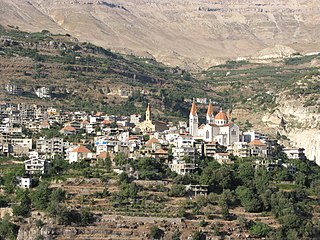
Bsharri is a town at altitudes between 1,100 m (3,600 ft) and 3,088 m (10,131 ft). It is located in the Bsharri District of the North Governorate in Lebanon. Bsharri is the site of the only remaining original “Cedars of God”, and is the birthplace of the famous poet, painter and sculptor Khalil Gibran. A museum in the town honours his life and work.

Fort Ancient is a Native American earthworks complex located in Washington Township, Warren County, Ohio, along the eastern shore of the Little Miami River about seven miles (11 km) southeast of Lebanon on State Route 350. The site is the largest prehistoric hilltop enclosure in the United States with three and one-half miles (18,000 ft) of walls in a 100-acre (0.40 km2) complex. Built by the Hopewell culture, who lived in the area from the 200 BC to AD 400, the site is situated on a wooded bluff 270 feet (82 m) above the Little Miami. It is the namesake of a culture known as Fort Ancient who lived near the complex long after it was constructed.

Achrafieh is an upper-class area in eastern Beirut, Lebanon. In strictly administrative terms, the name refers to a sector (secteur) centred on Sassine Square, the highest point in the city, as well as a broader quarter (quartier). In popular parlance, however, Achrafieh refers to the whole hill that rises above Gemmayze in the north and extends to Badaro in the south, and includes the Rmeil quarter.
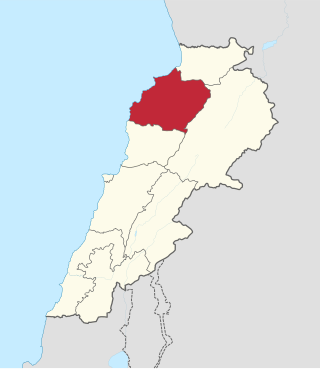
North Governorate is one of the governorates of Lebanon and one of the two governorates of North Lebanon. Its capital is Tripoli. Ramzi Nohra has been its governor since May 2, 2014. The population of North Governorate is 731,251.

The Beirut Central District is the historical and geographical core of Beirut, the capital of Lebanon. Also called downtown Beirut, it has been described as the “vibrant financial, commercial, and administrative hub of the country.” It is thousands of years old, with a traditional focus of business, finance, culture, and leisure.

The Temple of Bacchus is part of the Baalbek archaeological site, in Beqaa Valley region of Lebanon. The temple complex is considered an outstanding archaeological and artistic site of Imperial Roman Architecture and was inscribed as a UNESCO World Heritage Site in 1984. This monument to Bacchus is one of the best preserved and grandest Roman temple ruins; its age is unknown, but its fine ornamentation can be dated to the second century CE.
Lebanon was the name of two different communities that were founded in Texas in the 19th century, neither of which exist today. The first was a town located in Collin County that had a post office designated as Lebanon, Texas, before it was relocated to Frisco. The second was a smaller unincorporated community located in Live Oak County, of which only a cemetery remains today.

The National Museum of Beirut is the principal museum of archaeology in Lebanon. The collection begun after World War I, and the museum was officially opened in 1942. The museum has collections totaling about 100,000 objects, most of which are antiquities and medieval finds from excavations undertaken by the Directorate General of Antiquities.

The University of Balamand is a private institution, secular in its policies and approach to education. It welcomes faculty, students, and staff from all faiths and national or ethnic origins. The university is located in the northern district of El-Koura, Lebanon. It was founded by the Orthodox Patriarch Ignatius IV of Antioch in 1988. The university's main campus is adjacent to Balamand Monastery, but it has two other campuses in Beirut: One is in Sin el Fil, which houses the majority of the Lebanese Academy of Fine Arts, and the other neighbors Saint George Hospital in Achrafieh, which houses the faculty for medicine and medical sciences. It also has campuses in Akkar and Souk El Gharb.
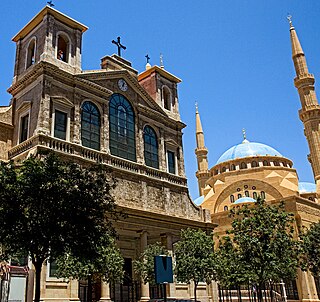
The tourism industry in Lebanon has been important to the local economy historically and comprises a major source of revenue for the country.

The following outline is provided as an overview of and topical guide to Lebanon:

Bsous Silk Museum is a silk museum in the town of Bsous near Wadi Chahrour in Lebanon, located around 15 kilometres east of Beirut.

The Holy Spirit University of Kaslik is a private, non-profit, Catholic university in Jounieh, Lebanon. The university was founded by the Baladites in 1950 and ratified under the new Higher Education Law of 1962. USEK is the first university in Lebanon to be established by Lebanese citizens.

Archaeology of Lebanon includes thousands of years of history ranging from Lower Palaeolithic, Phoenician, Roman, Arab, Ottoman, and Crusades periods.

The Museum of Lebanese Prehistory is a museum of prehistory and archaeology in Beirut, Lebanon.

















